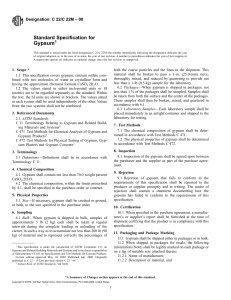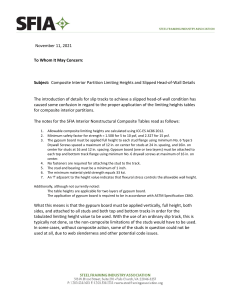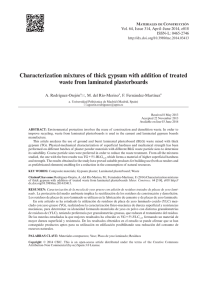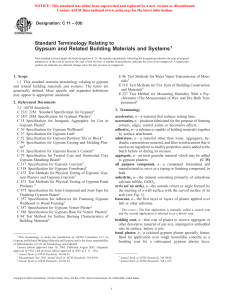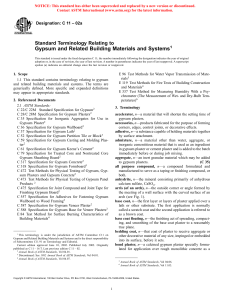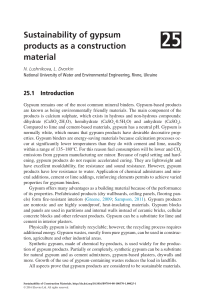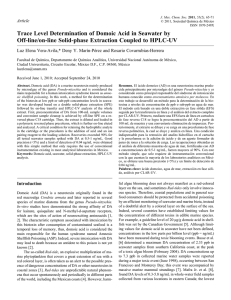Geo42 (4).PMD
Anuncio
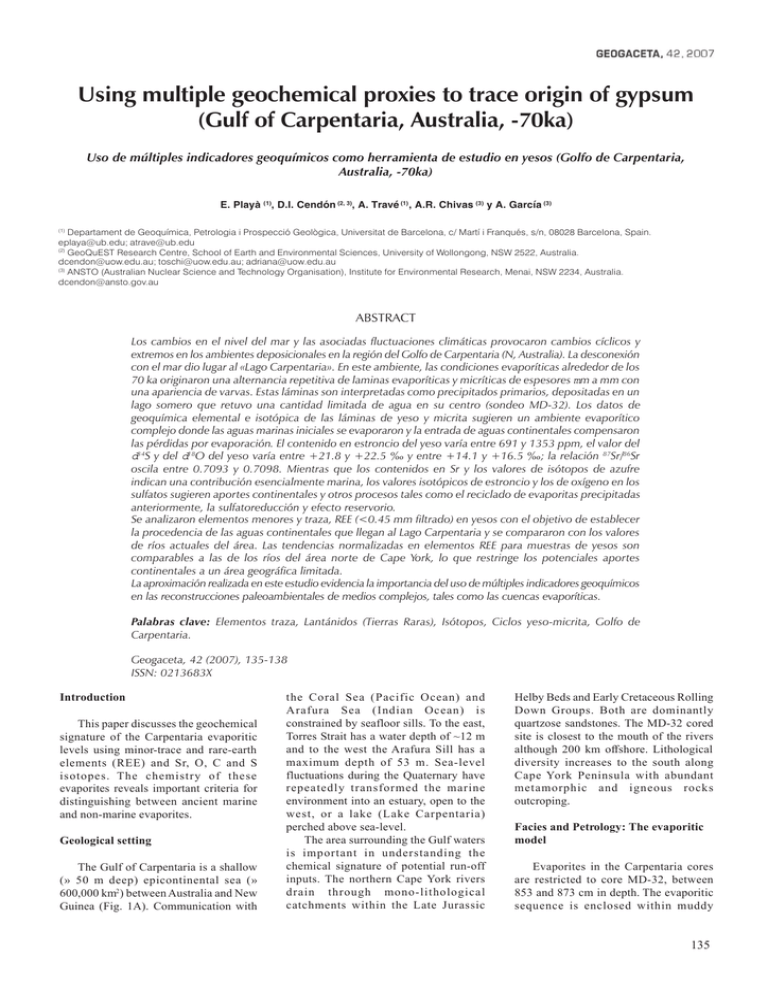
Using multiple geochemical proxies to trace origin of gypsum (Gulf of Carpentaria, Australia, -70ka) Uso de múltiples indicadores geoquímicos como herramienta de estudio en yesos (Golfo de Carpentaria, Australia, -70ka) E. Playà (1), D.I. Cendón (2, 3), A. Travé (1) , A.R. Chivas (3) y A. García (3) (1) Departament de Geoquímica, Petrologia i Prospecció Geològica, Universitat de Barcelona, c/ Martí i Franqués, s/n, 08028 Barcelona, Spain. [email protected]; [email protected] (2) GeoQuEST Research Centre, School of Earth and Environmental Sciences, University of Wollongong, NSW 2522, Australia. [email protected]; [email protected]; [email protected] (3) ANSTO (Australian Nuclear Science and Technology Organisation), Institute for Environmental Research, Menai, NSW 2234, Australia. [email protected] ABSTRACT Los cambios en el nivel del mar y las asociadas fluctuaciones climáticas provocaron cambios cíclicos y extremos en los ambientes deposicionales en la región del Golfo de Carpentaria (N, Australia). La desconexión con el mar dio lugar al «Lago Carpentaria». En este ambiente, las condiciones evaporíticas alrededor de los 70 ka originaron una alternancia repetitiva de laminas evaporíticas y micríticas de espesores mm a mm con una apariencia de varvas. Estas láminas son interpretadas como precipitados primarios, depositadas en un lago somero que retuvo una cantidad limitada de agua en su centro (sondeo MD-32). Los datos de geoquímica elemental e isotópica de las láminas de yeso y micrita sugieren un ambiente evaporítico complejo donde las aguas marinas iniciales se evaporaron y la entrada de aguas continentales compensaron las pérdidas por evaporación. El contenido en estroncio del yeso varía entre 691 y 1353 ppm, el valor del d34S y del d18O del yeso varía entre +21.8 y +22.5 ‰ y entre +14.1 y +16.5 ‰; la relación 87Sr/86Sr oscila entre 0.7093 y 0.7098. Mientras que los contenidos en Sr y los valores de isótopos de azufre indican una contribución esencialmente marina, los valores isotópicos de estroncio y los de oxígeno en los sulfatos sugieren aportes continentales y otros procesos tales como el reciclado de evaporitas precipitadas anteriormente, la sulfatoreducción y efecto reservorio. Se analizaron elementos menores y traza, REE (<0.45 mm filtrado) en yesos con el objetivo de establecer la procedencia de las aguas continentales que llegan al Lago Carpentaria y se compararon con los valores de ríos actuales del área. Las tendencias normalizadas en elementos REE para muestras de yesos son comparables a las de los ríos del área norte de Cape York, lo que restringe los potenciales aportes continentales a un área geográfica limitada. La aproximación realizada en este estudio evidencia la importancia del uso de múltiples indicadores geoquímicos en las reconstrucciones paleoambientales de medios complejos, tales como las cuencas evaporíticas. Palabras clave: Elementos traza, Lantánidos (Tierras Raras), Isótopos, Ciclos yeso-micrita, Golfo de Carpentaria. Geogaceta, 42 (2007), 135-138 ISSN: 0213683X Introduction This paper discusses the geochemical signature of the Carpentaria evaporitic levels using minor-trace and rare-earth elements (REE) and Sr, O, C and S isotopes. The chemistry of these evaporites reveals important criteria for distinguishing between ancient marine and non-marine evaporites. Geological setting The Gulf of Carpentaria is a shallow (» 50 m deep) epicontinental sea (» 600,000 km2 ) between Australia and New Guinea (Fig. 1A). Communication with the Coral Sea (Pacific Ocean) and Arafura Sea (Indian Ocean) is constrained by seafloor sills. To the east, Torres Strait has a water depth of ~12 m and to the west the Arafura Sill has a maximum depth of 53 m. Sea-level fluctuations during the Quaternary have repeatedly transformed the marine environment into an estuary, open to the west, or a lake (Lake Carpentaria) perched above sea-level. The area surrounding the Gulf waters is important in understanding the chemical signature of potential run-off inputs. The northern Cape York rivers drain through mono-lithological catchments within the Late Jurassic Helby Beds and Early Cretaceous Rolling Down Groups. Both are dominantly quartzose sandstones. The MD-32 cored site is closest to the mouth of the rivers although 200 km offshore. Lithological diversity increases to the south along Cape York Peninsula with abundant metamorphic and igneous rocks outcroping. Facies and Petrology: The evaporitic model Evaporites in the Carpentaria cores are restricted to core MD-32, between 853 and 873 cm in depth. The evaporitic sequence is enclosed within muddy 135 Fig. 1.- A) Location of studied core (MD-32) in the Gulf of Carpentaria (Australia). B) Log of core MD-32 from the Gulf of Carpentaria (modified after Chivas et al., 2001). The studied evaporitic-micritic level is enlarged. Several available dates are shown on the left; thermoluminescence (TL), optically stimulated luminescence (OSL), and amino-acid racemization (AAR). T refers to the transitions between marine and non-marine facies. Fig. 1.- A) Situación de los sondeos estudiados (MD-32) en el Golfo de Carpentaria (Australia). B) Log del sondeo MD-32 del Golfo de Carpentaria (modificado de Chivas et al., 2001). El nivel evaporíticomicrítico estudiado se presenta aumentado. Las dataciones disponibles se muestran a la izquierda; termoluminiscencia (TL), luminiscencia estimulada óptimamente (OSL), y racemización amino-ácida (AAR). T indica el tránsito entre facies marinas y no marinas. carbonate sediments with intercalations of silty clay and sandy levels (Fig. 1B). The evaporitic level is composed of an alternation of thin muddy carbonate and gypsum laminae (Fig. 2A, B). Individual laminae are from 50 mm to 15 mm in thickness. Thickness and purity of the gypsum laminae increases in the central part of the evaporitic succession and Fig. 2.- Resin-embedded fragment of core (A) and thin-section photomicrograph (B) of the gypsum-carbonate alternations in the evaporite-micrite level from core MD-32. G, gypsum; M, micrite; sample 863-864; crossed polars in 2B. Fig. 2.- Fragmento de sondeo englobado en resina (A) y fotografía de lámina delgada en nícoles cruzados (B) de las láminas alternantes de yeso-carbonato del sondeo MD-32. G, yeso; M, micrita; muestra 863-864, nícoles cruzados. 136 decreases towards the upper part, where the muddy carbonate laminae become more abundant. The bottom and top of each lamina are flat and continuous and display no dissolution features; discrete crenullations and, locally, possible tractive structures are present. Gypsum laminae are composed of fine-grained gypsum crystals, nearly equant and euhedral to subeuhedral, from 15 to 175 mm across (with a mean size of 30-80 mm). Gypsum is primary, precipitated as gypsum and not from hydration of previously precipitated anhydrite. Micritic calcite with crystals ranging from 5-10 mm in size is the main component of the carbonate laminae. The fine-grained gypsum crystals of the evaporitic laminae are interpreted as chemical precipitates within the brine body and/or close to the brine-air surface and accumulated at the substrate-brine interface, with a minor clastic component and little or no reworking. Good preservation of the crystal habits, microcrystalline size, purity, near absence of typical detrital accompanying minerals (e.g. quartz, mica), and lack of tractive structures support this interpretation. The studied interval has few clastic laminae intercalated within the chemical precipitates, which is interpreted as relatively high-energetic events (storms or flash-flooding from the continent); little reworking is also evident in some mixed laminae (gypsumcarbonate) and in the rough normal grading of some gypsum laminae, but relatively good preservation of the gypsum crystals points to an intrabasinal (and not extensive) reworking. The Carpentaria gypsum-carbonate cycles do not have lateral continuity, thus, the evaporitic layers within the Gulf of Carpentaria are interpreted as having been deposited in the marginal zone of a shallow permanent water body. Marine versus continental signatures in a transitional evaporitic setting Minor and trace element contents of gypsum The Sr contents in the studied gypsum samples range from 691 to 1353 ppm, with a mean of 1118 ppm (Fig. 3), which is consistent with marine-derived gypsum precipitates. However, the Sr contents in gypsum cannot be used by themselves as marine or non-marine indicators. Gypsum precipitated from mixed marinenonmarine brines can display typical Fig. 3.- Geochemical profiles of the evaporite-micrite level (MD-32; 853-874 cm) of the Carpentaria basin. Fig. 3.- Perfiles geoquímicos del nivel evaporítico-micrítico (MD-32; 853-874 cm) de la cuenca de Carpentaria. marine Sr contents when nonmarine influence is low or nonmarine waters are Sr-depleted. The Sr concentrations in the modern northern Australian river waters are low (from 2 to 15 ppb; Cendón et al., 2004a). The average 87 Sr/86Sr signature for northern Cape York rivers is 0.7148 (Cendón et al., 2004b). The low Sr concentration in the northern rivers would suggest that a large continental fluvial input would be necessary to produce the 8 7Sr/ 8 6 Sr values observed in the gypsum (0.7093 to 0.7098). However marine-derived Sr would have played a major role during gypsum precipitation. The Mn, Ni and Ba concentrations are mostly in the 1-5 ppm range. Li, V, Co, Cu, Zn, Rb and Pb range between 100700 ppb with Th and U in the low ppb range 5-25 ppb. These concentrations are similar to those reported in Toulkeridis et al. (1998) for gypsum grown in an organic-matter-rich mangrove soil, particularly for those elements more abundant in seawater. Elemental ratios can provide some clues on the origin of the different elements. For those elements whose concentrations in seawater are higher than in continental waters (i.e: Sr and Ba), gypsum samples have Ba/Sr ratios closer to that of seawater. However, for elements that are not conservative during evaporation (e.g. Mn) or when continental waters have concentrations within the same order of magnitude or higher than seawater (V, Co, Ni, Cu, Zn), the ratios are similar to those found in the continental waters (i.e. Ni/Cu). Thus, transition metals, show more variations as they are more affected by non-marine inputs. The Rb and Li contents of the Carpentaria gypsum samples are positively correlated (Fig. 3). Rb and Li behave similarly during brine evolution, accumulating in the marine brine during evaporation until the precipitation of K-Mg-bearing phases. The V contents in the studied gypsum samples are similar to those of Rb and Li, and display a similar trend, although V concentration in seawater is much lower than Rb and Li. All these arguments points to the presence of both marine and continental waters during gypsum precipitation. REE contents of gypsum The Y and REE concentrations in the gypsum samples are all in the low ppb range with lower concentrations for the HREE. The general knowledge of REE concentrations in gypsum is very limited. The concentrations reported here are overall, similar to those reported by Toulkeridis et al. (1998). All gypsum samples in core MD-32 show parallel REE patterns when plotted against MUQ (MUd from Queensland) (Kamber et al., 2005; Fig 4A). The relative levels of the LREE increase from La to Sm and those of the MREE and HREE are depleted in a decreasing order from Sm to Lu. The concentration of REE in seawater is much lower than in rivers. Therefore REE are mainly controlled by the continental input. Open seawater shows high Y and very low Ce with a gradual enrichment in REE concentrations from the light to heavy REE on a normalized plot (Fig. 4B). The REE distribution in the Carpentaria gypsum samples is basically the inverse of that observed in seawater and coincides closely with that determined in river waters from northern Cape York rivers (Fig. 4B). The normalized REE patterns for gypsum show that continental water input was restricted to a specific group of rivers from northern Cape York. In our data set (Fig. 4A) we propose that small variations of the gypsum REE distributions are due to seawater influence. Seawater presence is particularly noticeable in the LREE (Fig. 4B) where marine and continental water normalized values are more different. The Ce/Ce* anomaly (Fig. 3) suggests an increase in continental input from the bottom of the evaporitic sequence up to sample 858-859 (Ce/Ce*= 1.01) followed by a change to a more marine influence (Ce/Ce*= 0.89) towards the top of the gypsum sequence. Oxygen and sulfur isotopic composition of gypsum The d18 O V-SMOW values range from +14.1 to +16.9‰ (mean of +15.6‰), while the d34SV-CDT values vary in a narrow range between +21.8 and +22.5‰, with a mean of +22.1‰ (Fig. 3). Modern oceanic dissolved sulfate has d34S values in the range +19.3 to +21.12‰. Taking into account the average gypsum-water 34 S fractionation +1.65 ‰, the original brine would have had an average d34S value of about +20.5‰ well within normal marine values. In the case of oxygen, modern seawater values range between +8.6 and +10.1‰. However considering the fractionation due to crystallization, d18O=+3.5‰, the average original brine in the core MD-32 samples would have had a d18 O=+12.1‰, well above the expected marine ä 18 O value of about +9.5‰. This is quite common in evaporitic environments, where the isotopic enrichment commonly pertains to a bacterially mediated process. Furthermore a small proportion of Figure 4: A) MUQ-normalised pattern of gypsum REEs (Kamber et al., 2005). B) Gypsum average REE pattern (x10 3). Rivers average REE pattern (x106) for all 3 major rivers in Cape York Peninsula, including tributaries. Seawater: average REE pattern (x109) for the 5 and 49 m depths. Figura 4: A) Contenidos en REE de los niveles de yeso, normalizados respecto a MUQ (Kamber et al., 2005). B) Contenidos promedio en REE de: Yeso (x103). Ríos (x106); valores de los 3 mayores ríos de la Península Cape York, incluyendo afluentes. Agua marina (x106) muestreada a 5 y 49 m de profundidad. 137 internal recycling cannot be ruled out. The low topographic gradient of the basin would favour dissolution processes with rising water levels. The oxygen and sulfur isotopic compositions display a similar vertical evolution; Sr contents covary inversely with isotopic values. This suggests that bulk changes in the composition of the brines affected the three components (Sr, O, S) together, which cannot be explained by evaporation alone. These vertical changes could be interpreted as the result of successive opening and restriction of the evaporitic basin. Increasing Sr contents could reflect an increase of salinity due to higher evaporation. Decreasing d34 S and d18O values in the precipitated gypsum would be due to a reservoir effect in the brine; compatible with a relatively closed basin. Restriction of the basin and disconnection from the sea need not be total; the isotopic composition of sulfur lies within the normal marine range, suggesting a seawater influx before the onset of evaporation or more plausible a large remnant seawater body left trapped as a lake after sea-level fall. Furthermore, the sulfate concentration in the northern river waters is very low, much less than 1 ppm, and their major ion ratios are like those found in seawater with their sulfate isotopic composition expected to be similar to that of the seawater (Chivas et al., 1991). Strontium isotopic composition of gypsum The strontium isotopic ratios of the gypsum have values ranging from 0.70932 to 0.0977, with a mean of 0.70951 (Fig. 3). The 87 Sr/86 Sr ratios for the Carpentaria gypsum samples are more radiogenic than the value for modern seawater of 0.70920. The strontium isotope ratios of the ocean during the time (~70 ka) of Carpentaria gypsum precipitation were not different from that of modern seawater. Cendón et al. (2004b) calculated an approximate weighted average of the 87Sr/86Sr of all rivers in the Gulf of Carpentaria during the dry-season, obtaining an estimate value of 0.7178. The 87Sr/86Sr of northern Cape York rivers is less radiogenic, average 0.7148. Therefore the influence of non-marine waters that are more radiogenic than seawater in the 138 Carpentaria region is highlighted by the strontium isotope compositions. The oxygen and strontium isotopic compositions of gypsum display a slight positive covariance, suggesting an increase in continental input probably associated with dissolution of previously deposited gypsum with rising water level in Lake Carpentaria. d18 O, carbonate-d13C and d18 O values, Sr/86Sr and REE show the influence of continental inputs varying throughout evaporite deposition. The combination of these geochemical markers together with detailed petrography has allowed a sound palaeoenvionmental reconstruction. 87 Acknowledgments Palaeogeographic implications and conclusions The evaporitic level of core MD-32 is stratigraphically very close to the transition between marine and nonmarine conditions (Fig. 1B), on the basis of Foraminifera and Ostracoda assemblages (Reeves et al., 2007a). The evaporitic level, from available age constraints, and facies coupled to sealevel changes corresponds to Marine Isotope Stage (MIS) 4 (Reeves et al., 2007b, in press). Throughout evaporite deposition, sea-level remained below the level of the Arafura Sill (-53 m). However, a localized increase in marine influence suggests that the sea-level was close to the Sill with storms, peak high tides or other sporadic causes (i.e. tsunamis) possibly being able to breach the sill. When evaporitic conditions started, the initial Carpentaria Lake water would have been mostly marine (Chivas et al., 2001). The prevalent dry conditions would have driven evaporation, causing a vast land surface to be exposed, with water receding to the deepest part of the basin around the position of core MD-32. The evaporitic conditions (dry-climate) reached its maximum during precipitation of the central laminae, after which continental inputs start to be more noticeable. The lake reached its equilibrium once the volume of total evaporation losses were approximately balanced for by riverine inflows. During the process leading to a «sustainable» lake, evaporite deposition took place. The multiple approach taken in this study highlights the importance of avoiding single-parameter palaeoenvironmental reconstructions in complex settings such as evaporative basins. Although Sr concentrations and the sulfate-d34S values show an initial marine origin for the brines, sulfate- The present work was supported by the Spanish Government Projects CGL2005-05337/BTE, CGL200507445-C03-01/BTE and CGL200604860, the Australian Research Council grants A39600498 and DP0208605, the AINSE grants and the Grup Consolidat de Recerca Geologia Sedimentària 2005SGR-00890. References Cendón D.I., Chivas A.R. y García A. (2004a). En: 17th Australian Geological Convention. Dynamic Earth: Past, present and future. Abstracts, 73, 228. Cendón, D.I., Chivas, A.R., Wyndham, T. y García, A. (2004b). En: 32nd International Geological Congress. CD publication. Chivas, A.R., Andrew, A.S., Lyons, W.B., Bird, M.I. y Donnelly, T.H. (1991). Palaeogeography, Palaeoclimatology, Palaeoecology, 84, 309-332. Chivas, A.R., García, A., van der Kaars, S., Couapel, M.J.J., Holt, S., Reeves, J.M., Wheeler, D.J., Switzer, A.D., Murray-Wallace, C.V., Banerjee, D., Price, D.M., Wang, S.X., Pearson, G., Edgar, N.T., Beaufort, L., De Deckker, P., Lawson, E. y Cecil, C. B. (2001). Quaternary International, 83-85, 1946. Kamber, B.S., Greig, A. y Collerson, K.D. (2005). Geochimica et Cosmochimica Acta, 69, 1041-1058. Reeves, J.M., Chivas, A.R., García, A. y De Deckker, P. (2007a). Palaeogeography, Palaeoclimatolology, Palaeoecology, 246, 163-187. Reeves, J.M., Chivas, A.R., García, A., Holt, S., Couapel, M.J.J., Jones, B.G., Cendón, D.I. y Fink, D. (2007b). Quaternary International. (en prensa) Toulkeridis, T., Podwojewski, P. y Clauer, N. (1998). Chemical Geology, 145, 6171.
